Options in Cut to Shape Aluminum and Plastic Nameplates
Cut to Shape
While many aluminum and plastic nameplates and labels utilize standard shapes like circles, ovals, squares and rectangles, sometimes the traditional just doesn't fit the design. This can be true especially if the logo or the brand name needs to be a focal point. When your design calls for this type of identification, the answer can be to die cut the nameplate to the shape of the letters or graphic. This will allow the image to be the predominant feature of the label. This type of tooling is possible for both aluminum and plastic nameplates and labels.
Aluminum Nameplates
Decorating options for aluminum nameplates are wide open. You can simply have the graphics printed for an attractive part. You also can step it up and add mechanical finishes to add movement and interest. Emboss adds height. Diamond cut adds crispness and sharp detail. The final decision is up to you.
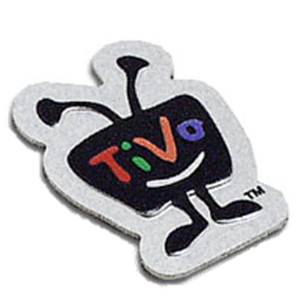

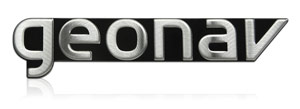
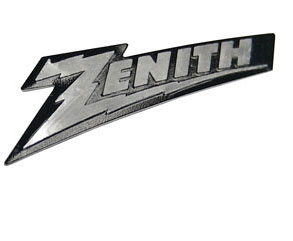
Whenever your design calls for a unique shape using aluminum material, a custom tool will be required. The label can be flat or an emboss can be configured. Minimum .005" spacing needed around perimeter of the part when embossed graphics are used. This ensures minimum contact area for bonding to the OEM product. These examples show the cutting to shape and embossed graphics. If there was not the slight edge around the outside of the parts, there would not be surface area for the nameplate to bond to the end product since the embossing raises the surface of the aluminum.
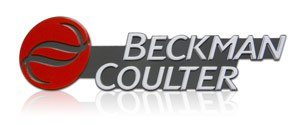

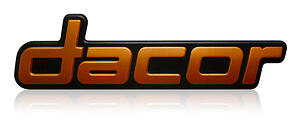

Standard tolerance range of ±.005" need to be taken into consideration for the size of the part and ±.015" should be used for registration of graphics to the blank. Tolerances are subject to review on a case by case scenario.
Plastic Labels
Plastic labels come in polycarbonate or polyester substrates. Just like on aluminum, decorating options are open for you to consider. Transferring the design from artwork to the material can take place using printing and screening techniques. Opaque and transparent colors as well as halftones can be combined to achieve the desired look. Polycarbonate starts out clear which provides additional option to have clear areas within the design. This can be beneficial to allow the OEM product housing color to show through the design.
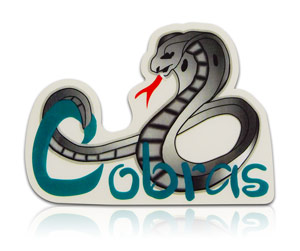
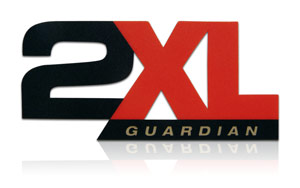
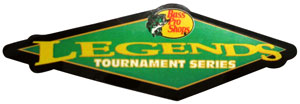
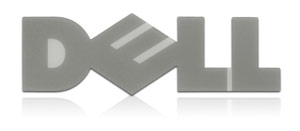
A custom tool or cutting program is required for plastic labels so that the final shape and cut is to your design. Any corner requires a minimum radius of .032" in order to have a repeatable and manufacturing friendly design. Standard tolerance range of ±.015" need to be taken into consideration for the size of the part and ±.015" should be used for registration of graphics to the blank. Tolerances are subject to review on a case by case scenario.
Attachment
Attachment to the end product is always a consideration. Many times a pressure sensitive adhesive is adequate. Removing the adhesive can be simplified by having a break-away tab for the aluminum to pull away the liner which allows you to press the nameplate onto the mating surface. Tooling operations can include snap-in features for aluminum nameplates. On plastic the pull away adhesive liner can be slit so that it is removed in sections which can help during assembly. If there are individual letters, a carrier with positioning mask helps to maintain straight alignment.
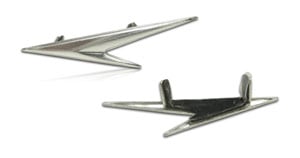
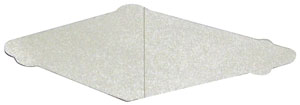

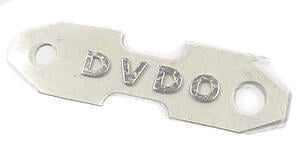
Open Possibilities
Cutting to the shape of the letters allows for the nameplate or label to sit in a recess of the end product housing. This creates a finished and complete look for the brand. While this type of look has been popular in consumer electronics and computers, it can work with nearly any industry or product. The flexibility to use either aluminum or plastic substrates increases your options for decorating. The possibilities are wide open and friendly for most designs.
Where could you use a nameplate that is cut to shape?
Subscribe to Nameplate Blog
- 3D (4)
- Adhesives (11)
- Aluminum (137)
- Aluminum In-mold (9)
- Aluminum Trim (41)
- Anodize (4)
- Appliance (14)
- Appliqué (7)
- Archive (43)
- Artwork Submission (4)
- Assembly (6)
- Automotive (37)
- Backlit (6)
- Boats (7)
- Brass (8)
- Brushed Aluminum (19)
- Carbon Fiber (2)
- Chrome Polyester (14)
- Classic (1)
- Coined (5)
- Color Development (26)
- Computers (13)
- Cosmetics (30)
- Custom Patterns (12)
- Customization (16)
- Customized Patterns on Aluminum (2)
- Debossing (13)
- Diamond Cut (22)
- Digital Printing (2)
- Domed Labels (46)
- ebook (4)
- Electronics (25)
- Embossing (60)
- Etched (21)
- Exterior (11)
- FAQ (30)
- Faux Finish (1)
- Faux Finishes (10)
- Favorite Nameplate (23)
- Flexible Labels (37)
- Furniture (12)
- Gauges (7)
- Gloss (4)
- Hang Tag (1)
- IDSA (1)
- In-mold Decoration (5)
- Individual Letters (13)
- Inlay (1)
- Key Fob (3)
- Labels (17)
- Large Vehicle (5)
- Laser Etch (2)
- Lithography (3)
- Match Box Cover (6)
- Materials and Processes (132)
- Mechanical Finishes (53)
- Medical Equipment (12)
- Metallic (9)
- Motorcycle (13)
- Nameplate (186)
- Nameplate Examples (59)
- Nameplate Tools (7)
- Outdoor Equipment (5)
- Overlay (8)
- Packaging (17)
- Patina Finish (3)
- Plastic (14)
- Plastic Trim (4)
- Point of Purchase (12)
- Polycarbonate (19)
- Process Color (19)
- Promotional Products (40)
- Prototypes (2)
- Recreational Vehicles (7)
- Resources (11)
- Safety Labels (2)
- Selective Patterns (10)
- Sill Plate (6)
- Sports Equipment (11)
- Stainless Steel (17)
- stock dies (10)
- Surfaces (4)
- Sustainability (1)
- Technical (1)
- Telecommunications (10)
- Testing (3)
- Texture (15)
- Top 10 (9)
- Woodgrain (2)






